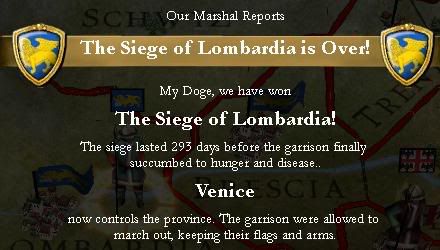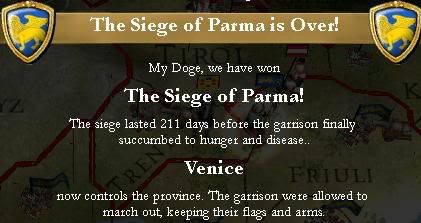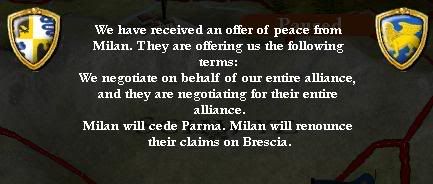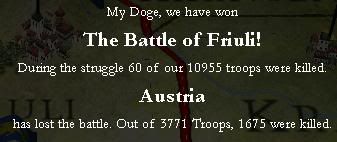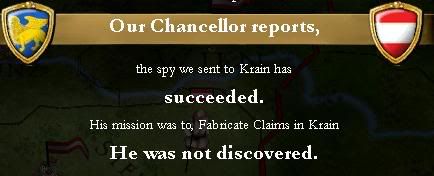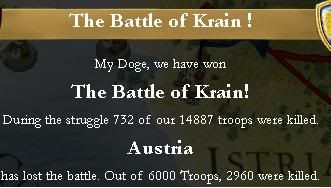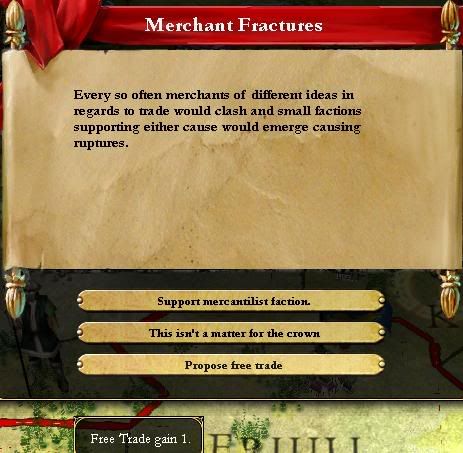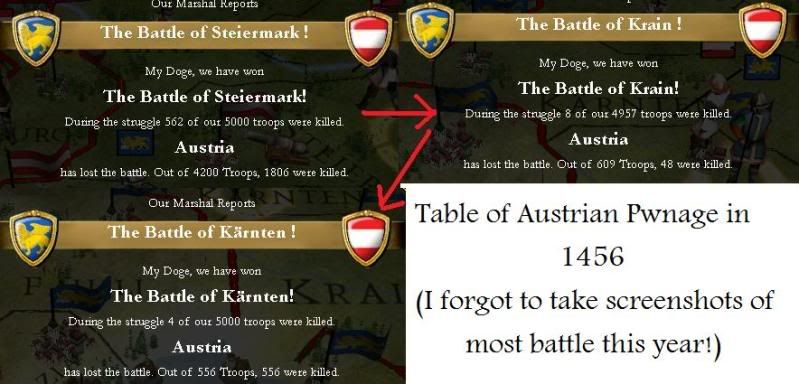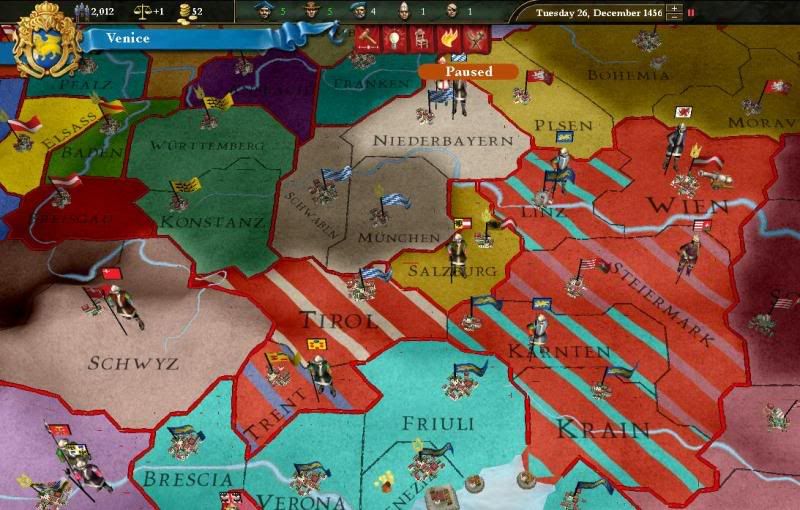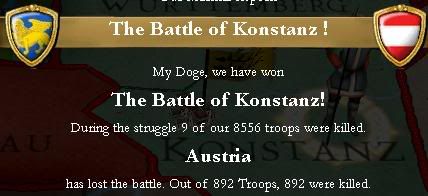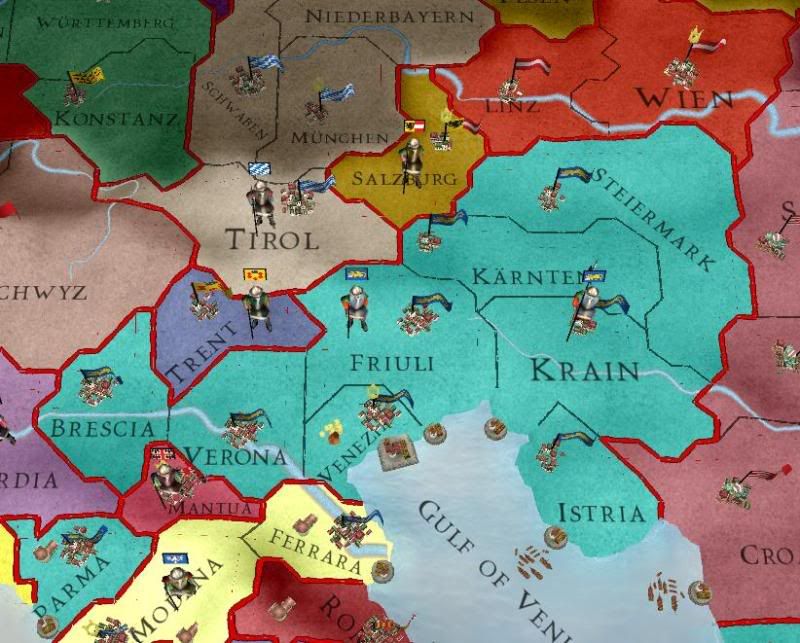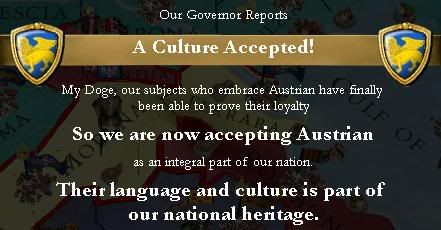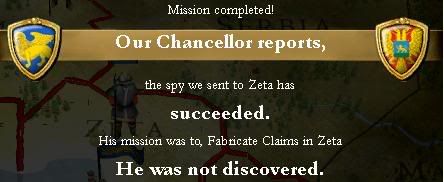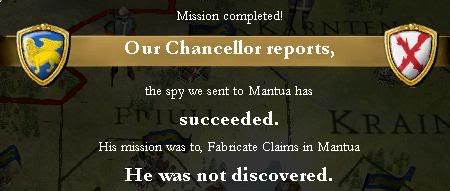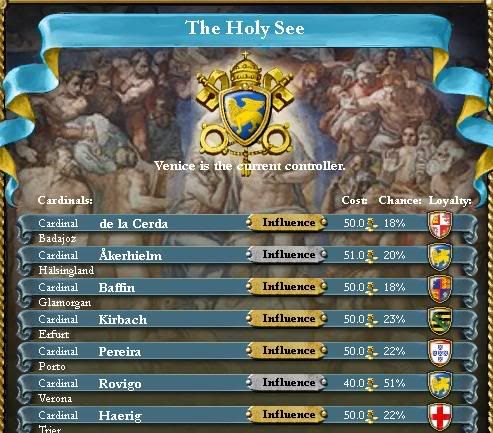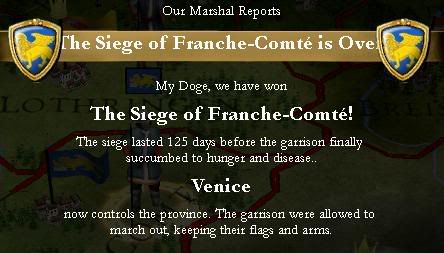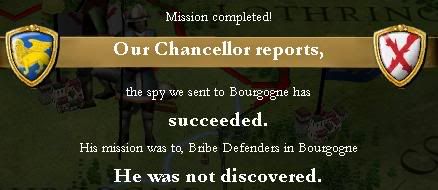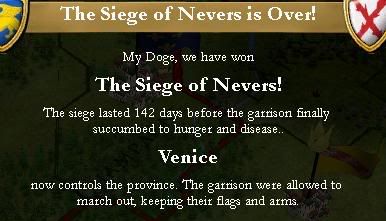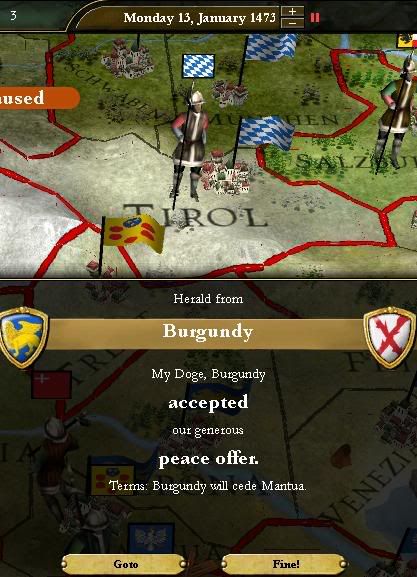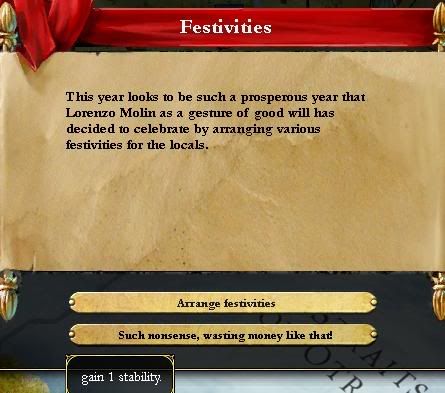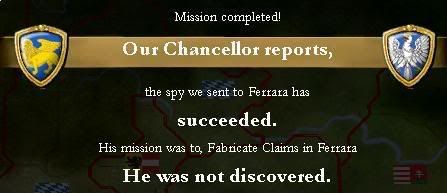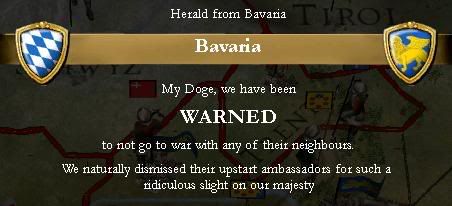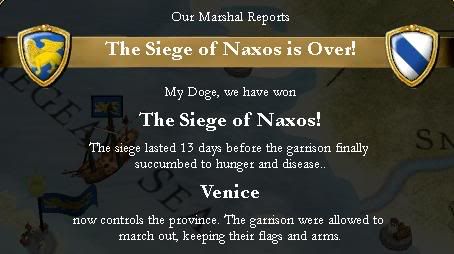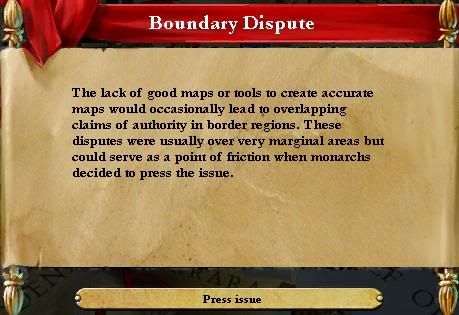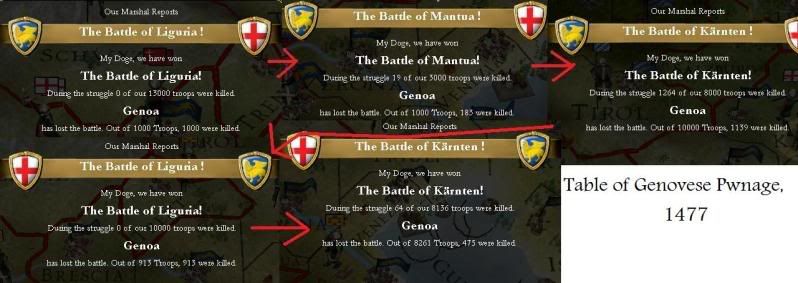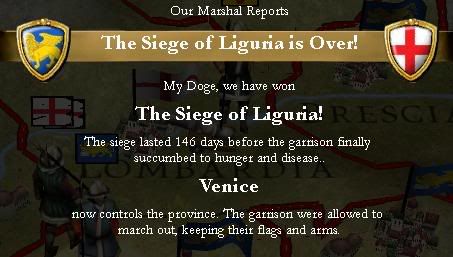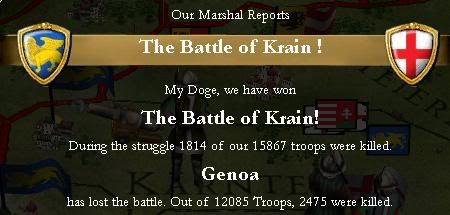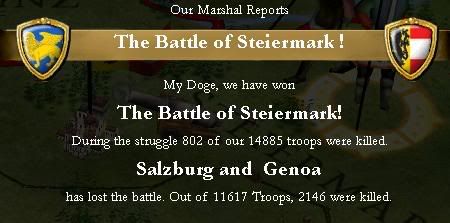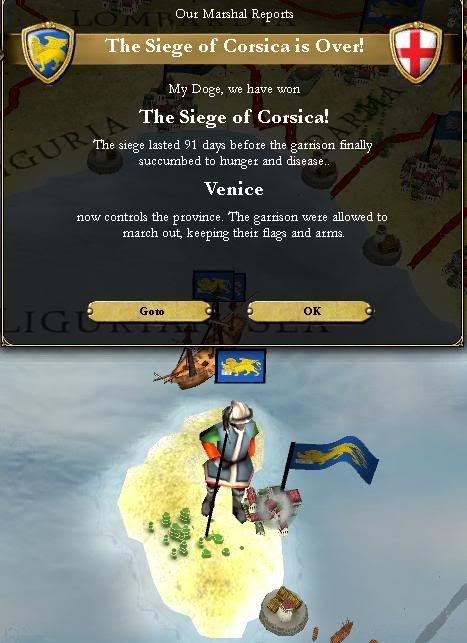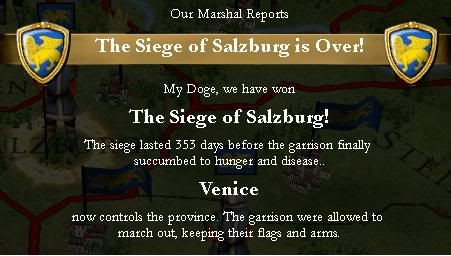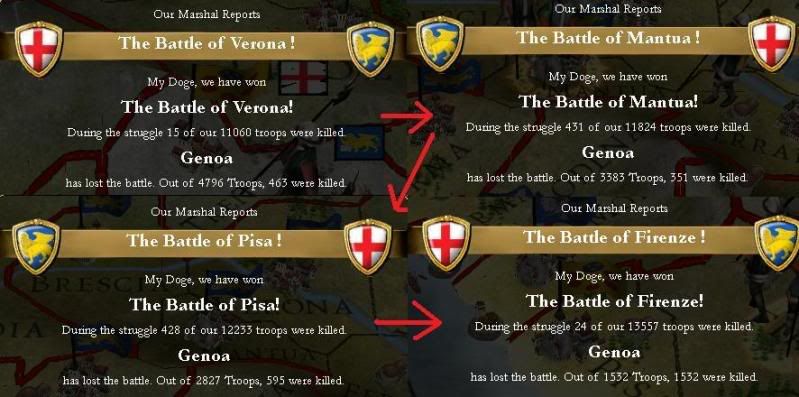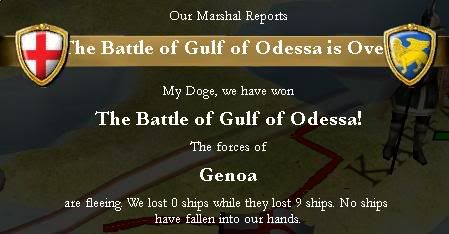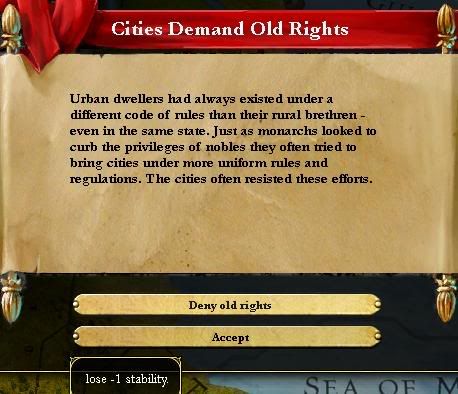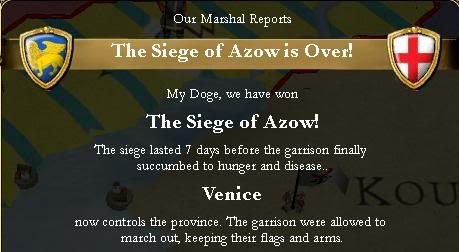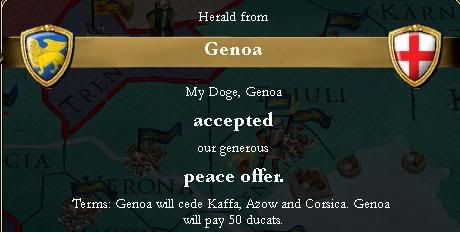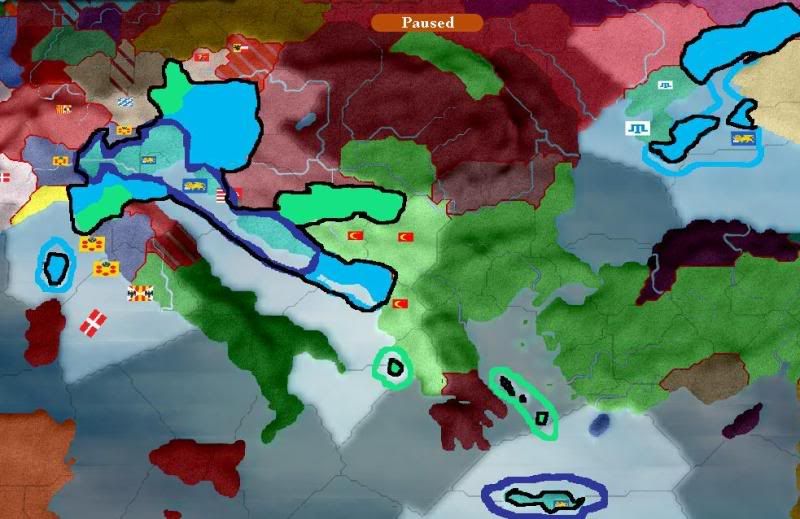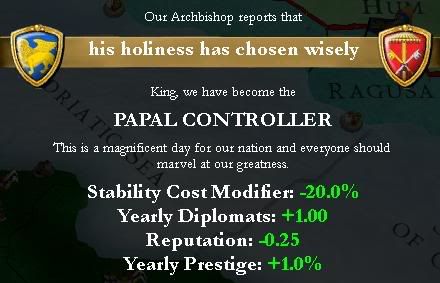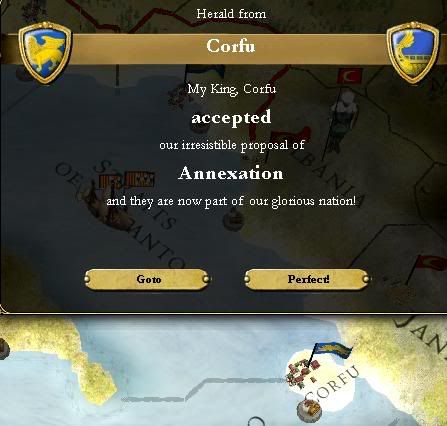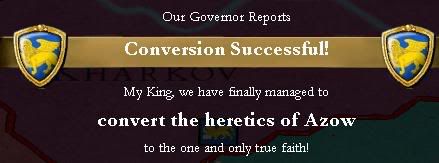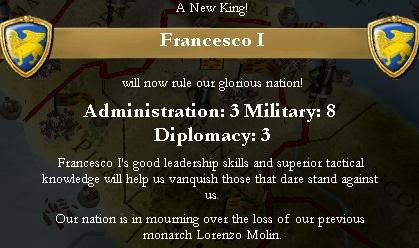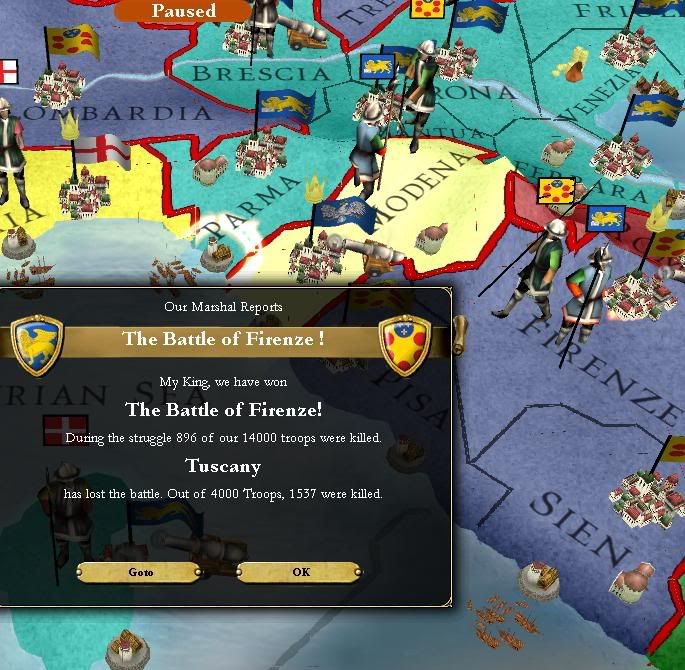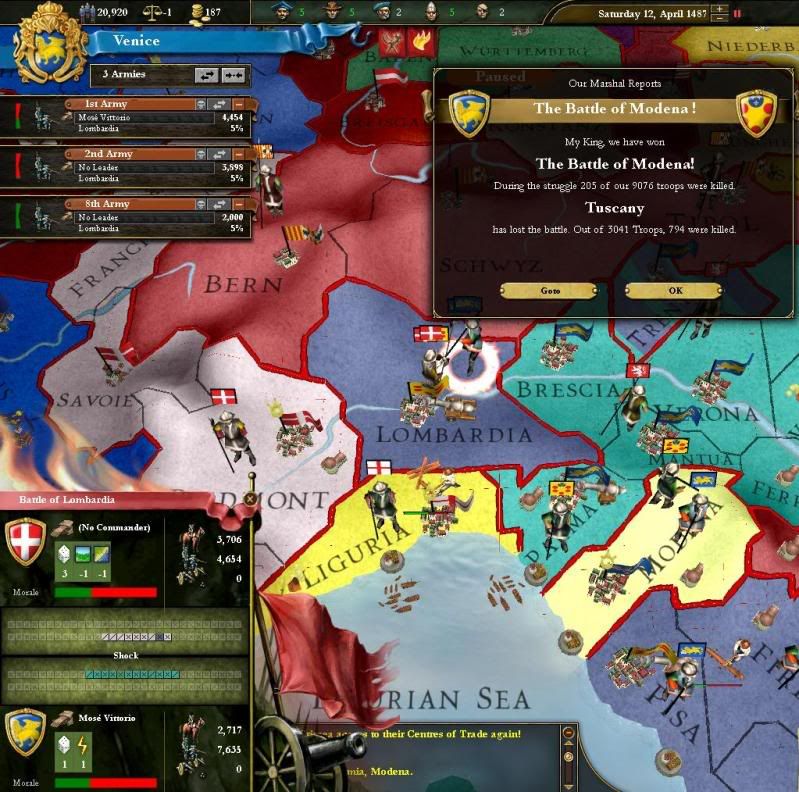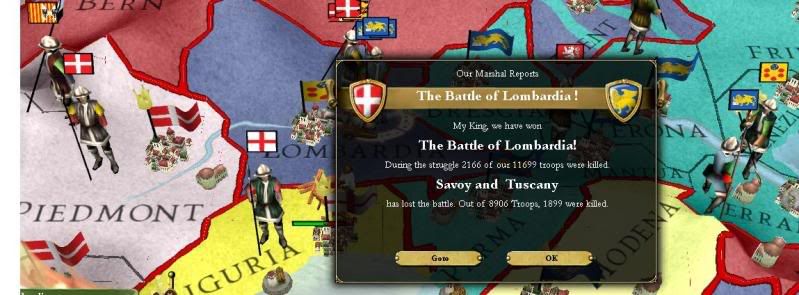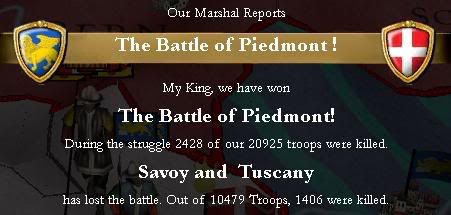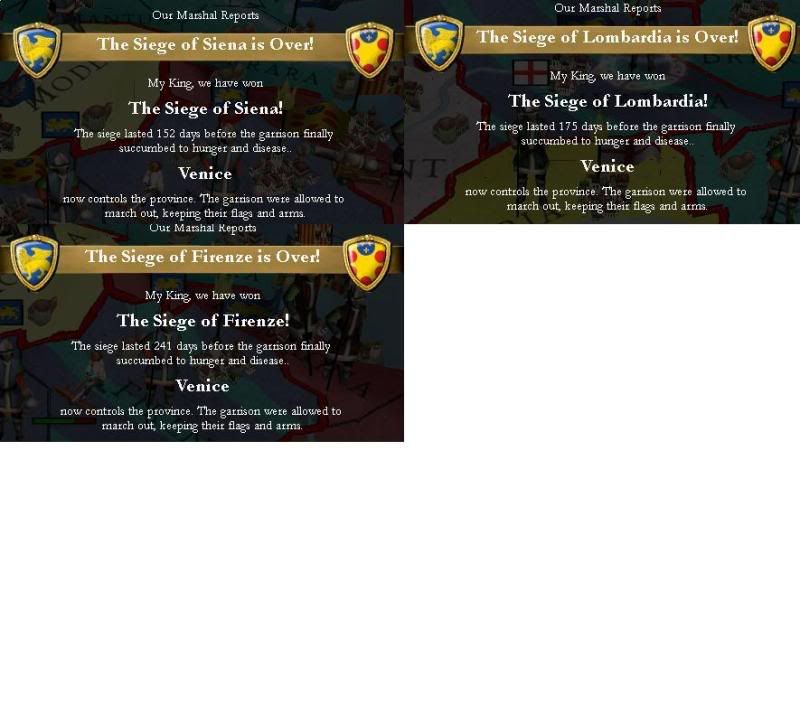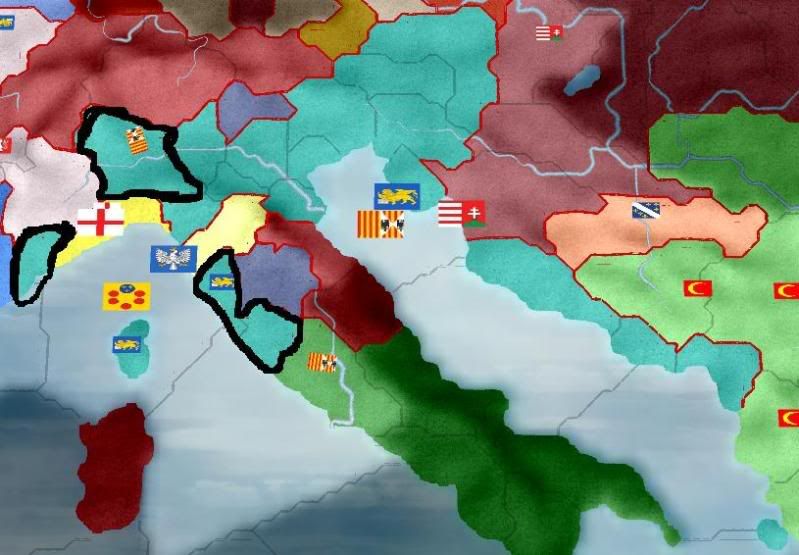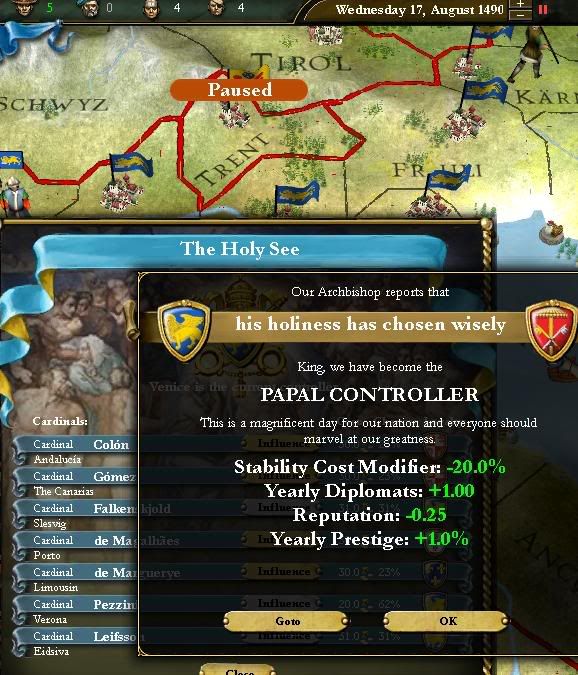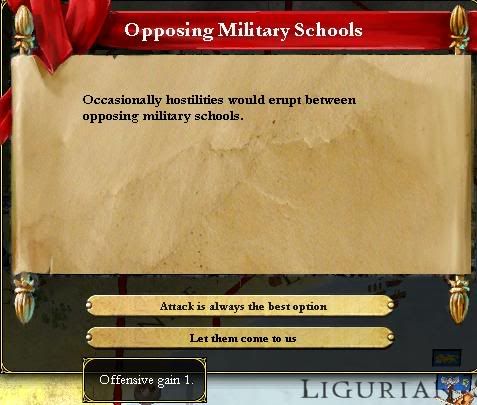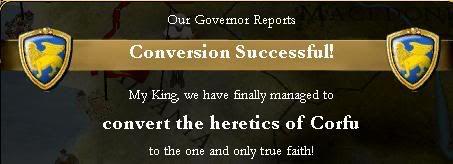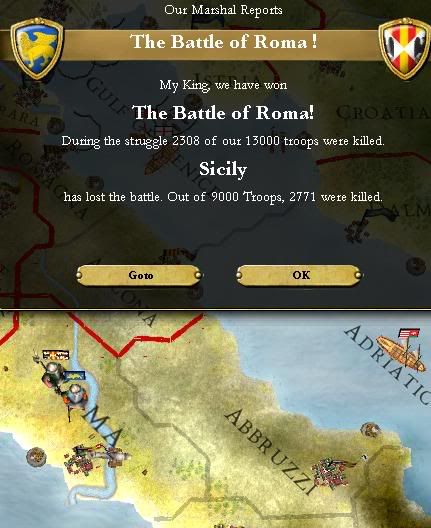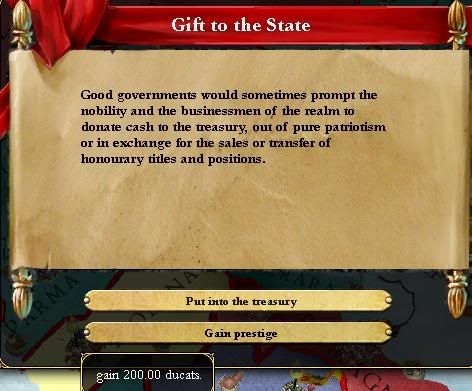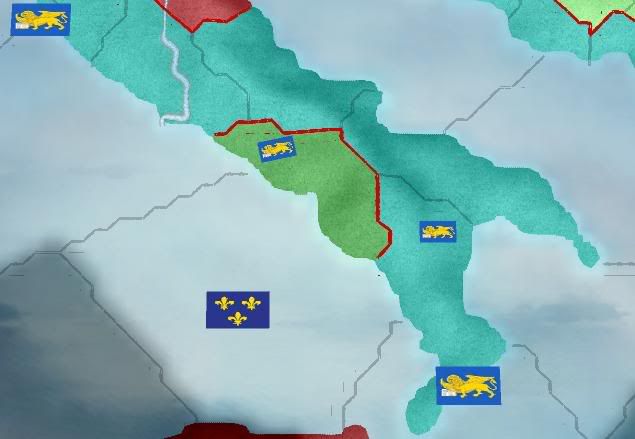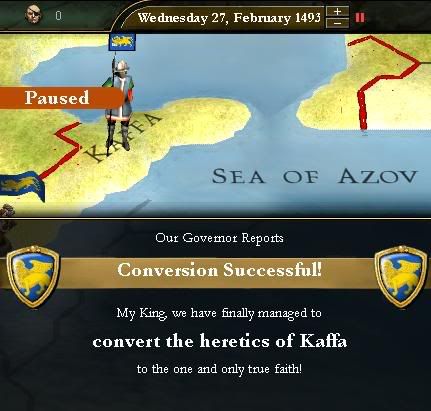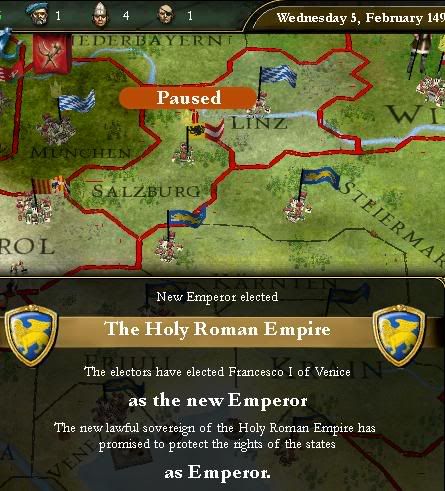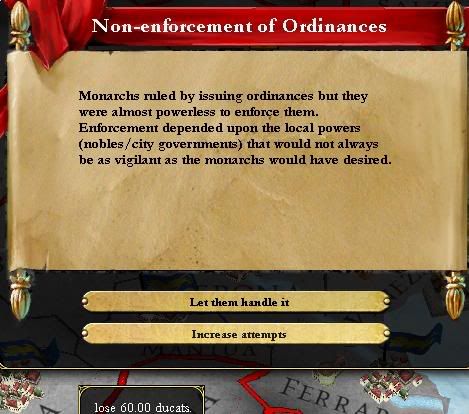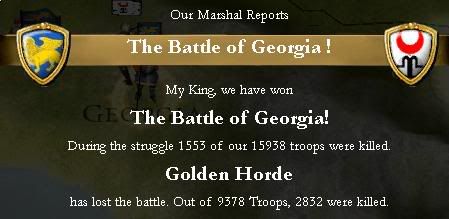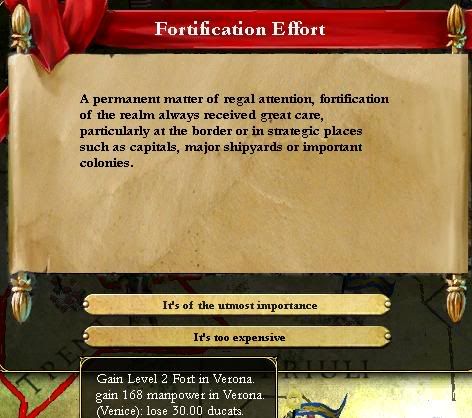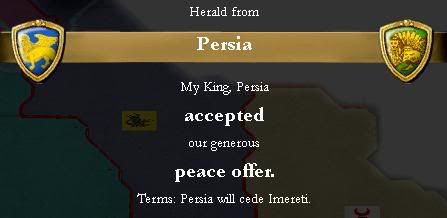Tani Coyote
Son of Huehuecoyotl
- Joined
- May 28, 2007
- Messages
- 15,191
The Most Serene Empire - A Venice EU3 AAR
Hey all, figured I'd give a EU3 AAR a try. Once more, as the Serenissima; Venice.
Before we begin, let me say a few things...
First, this is on my new computer, which is why I'm not working on my Civ III stories, which are on my old one. Now that I have EU3, I may not even think about my EU2 stories, sorry.
Second, the start date is May 30, 1453. Need as much time as possible to conquer the world!
Thirdly, I'll be tweaking this game a bit. I've reduced the cost to Fabricate Claims to 10 ducats. This can be increased with my empire's size as it grows. The rest of the spy actions remain unchanged, including their discover/failure risk. I've made it so it's near-impossible to lose accepted cultures. Finally, I will add in events where I feel they'd be good, due to how EU3 seems to lack a lot of historical events in Vanilla and is more of a "divergence point" from your start date than a recreation of history. The Holy Roman Emperor now gets 1 extra spy a year(he needs to keep an eye on his "subjects", does he not?) while the Curia Controller gets 1 extra missionary a year(c'mon now, why the hell would a good Catholic ruler not be trying to convert people?). War exhaustion decreases slightly faster as well. The Emperorship has been strengthened a little more as the benefits to stability for each member state have been doubled.
Now, let us begin!
Venice is a city of great beauty. It is one of the largest cities in Italy and all of Europe, with many of it's residents being wealthy merchants. A great trade center formed in the lagoon; Venice dominated the trade between the West and East.
But in the turmoil-filled 1400s, Venice, the most serene Republic, could not sit back idly. To the west, Milan, under the tyrant Francesco Sforza, threatened the Republic, and the Honorable Doge Foscari had engaged the Milanese in combat. We would depose the despot to the west, and restore our freedom-loving brothers, the Ambrosian Republic!
To facilitate the war on Sforza, Venice had many resources. We had colonies and vassals stretching all the way to Crete, and a large tax collection base from our center of trade. Our armies were competent, and our homeland stable. With the right application of our strengths, we would drive the tyrant from Milan and secure our fortunes.
To the east, the Ottoman Turks had captured Constantinople and brought the guillotine down on the ancient Roman Empire. They already hungered for our Christian friends in the Balkans. A close eye would need to be kept on them.
The Reign of Francisco Foscarini ( April 5, 1423 - February 20, 1454 )
1453

The Doge saw Sforza has left Milan defended by a mere four regiments, whereas we had seven ready to attack. But wanting to play it safe, he ordered regiments from the East to move to Brescia. A band of mercenaries - one regiment of Medieval Latin Infantry and one regiment of Medieval Latin Cavalry - was commissioned in Brescia. Once the other unit arrived, we would have a solid force of 10,000 troops, and the man to lead this army into battle would be General Gattamaletta.
Within days of our maneuvers, we received news that Sforza himself - being a general - would lead the Milanese Army to defend the capital province. Gattamaletta was promised a handsome bounty if he could bring the head of the tyrant back to Venezia.
The armies engaged in combat in July, and the battle was very bloody. But, Venice's forces were victorious. On July 29, 1453, Sforza fled the battlefield and headed south to Parma, taking his forces with him. Sensing opportunity, Gattamaletta pursued him southwards, while a new mercenary regiment held down the fort in Milan.
Sforza was defeated yet again on August 18, 1453. The Battle of Parma was a great victory, as Venice lost very few troops while the Milanese suffered horrific casualties. Milan's army now had lost nearly 40% of it's strength, while Venice had lost only 10%.
Sforza knew that he could not continue to fight Venice like this, and he ordered a retreat to Modena. Venice, lacking military access, could not follow. But the Doge sent a diplomat to get Modena's favor and earn military access.
A day later, the Modenan King agreed to let the Serenissima's troops enter, knowing such an agreement would protect him from Venice's wrath. The Reaper was coming for Sforza.
Mid-August, Foscari ordered the Venetian Navy's galleys to round the Italian peninsula and attack the Milanese navy, to secure a propoganda victory.
Furthermore in August, the battle of Modena was a minor conflict, as neither side wished to earn the ire of the Modenans for destroying their country.
Shortly after the Battle of Modena, Foscari revealed documents showing that the Parmese desired to join Venice, and thus Venice had legitimate claims to the area:
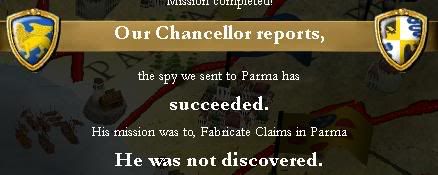
September saw the second Battle of Parma, which saw the Milanese suffering another huge blow. Sforza once more retreats into Modena, like it will help him. The Fleet managed to finish half of it's journey, now going through the straits of Messina.
Sforza suffered another defeat in October. As a bonus, the Milanese navy lost a ship in battle.
November brought another huge defeat to Milan.
Reduced to 30% of his original force, Sforza's day were numbered. In a suicidal assault, he dared to move back towards Milan itself. Gattamaletta pursued him, knowing that the Sforzan forces would collapse if they were flanked.
Between the battles, an unknown country managed to fabricate claims in Brescia; we imagined it was Sforza, as he was right next door. Despite the official report saying it was unknown, it was indeed Sforza; reports showed that Milan now considered Brescia a core province.
Sforza's desperate assault failed, and he managed to escape. Gattamaletta pursues him like cat would a mouse.
1454
January and February were tense months.
Sforza fled to Milan, and hardpressed the 1,000 soldiers present. As our general tried to reach Milan, he was assaulted by not one, but two regiments that popped out of nowhere, presumably detachments from Sforza's Army. The dictator had assumed he could hold Gatta back long enough to retake Milan and rebuild his empire from there. He was wrong.
In February, General Gattamaletta finally arrived in Milan. And shortly after...
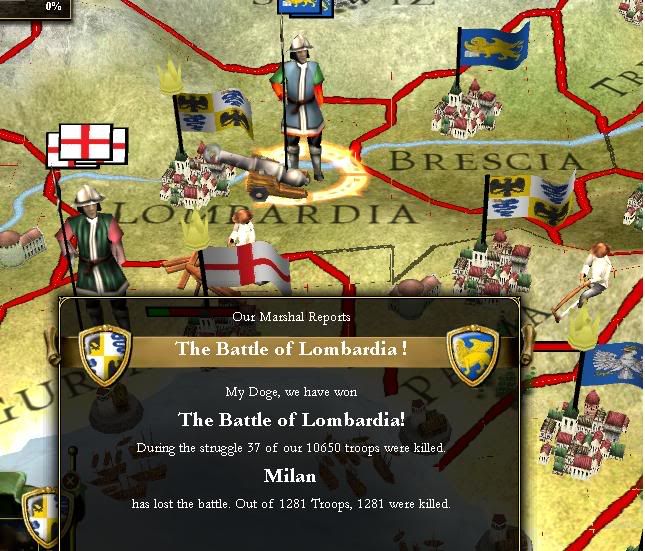
The Milanese Army was COMPLETELY destroyed! All Milan could now be freely occupied. Duke Sforza was dead, and general Gatta briefly returned to Venice and showed the head to the Doge. He was promptly invested with a great estate for defeating Public Enemy Number One.
A table of pwnage in relation to General Sforza's forces:
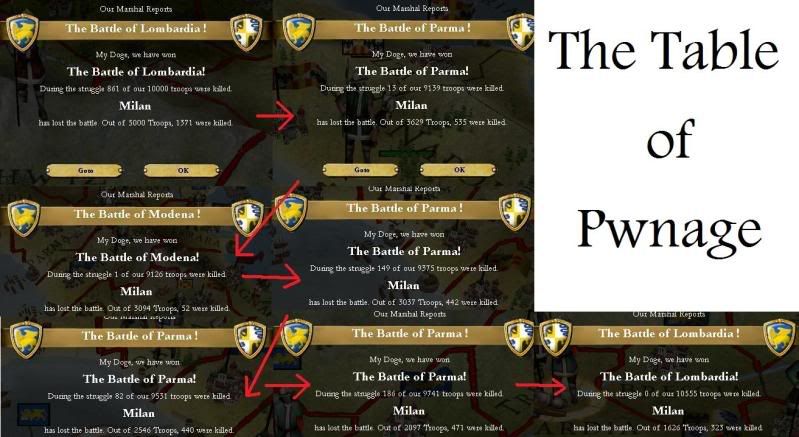
Duke Ascanio took control of Milan shortly after Sforza was killed, but his reign as Duke was to be shortlived. The Venetian Army split up after Sforza's demise, with most of the cavalry moving southeast to occupy and pillage Parma.
But the Honorable Foscari did not taste victory for long. Soon, he joined Sforza in the next world:
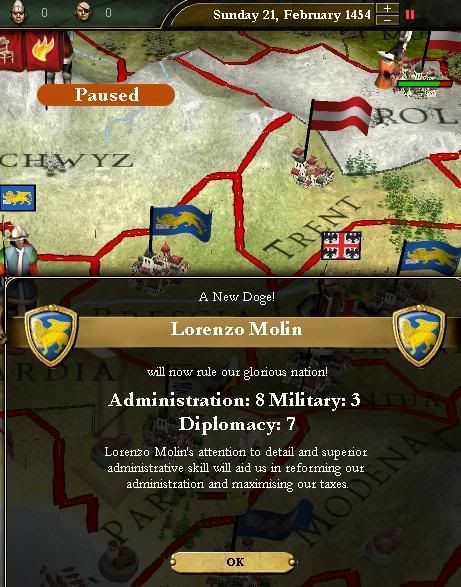
It would fall to his successor, Doge Lorenzo Molin, to defeat Milan.
... And something far worse.
Hey all, figured I'd give a EU3 AAR a try. Once more, as the Serenissima; Venice.
Before we begin, let me say a few things...
First, this is on my new computer, which is why I'm not working on my Civ III stories, which are on my old one. Now that I have EU3, I may not even think about my EU2 stories, sorry.

Second, the start date is May 30, 1453. Need as much time as possible to conquer the world!
Thirdly, I'll be tweaking this game a bit. I've reduced the cost to Fabricate Claims to 10 ducats. This can be increased with my empire's size as it grows. The rest of the spy actions remain unchanged, including their discover/failure risk. I've made it so it's near-impossible to lose accepted cultures. Finally, I will add in events where I feel they'd be good, due to how EU3 seems to lack a lot of historical events in Vanilla and is more of a "divergence point" from your start date than a recreation of history. The Holy Roman Emperor now gets 1 extra spy a year(he needs to keep an eye on his "subjects", does he not?) while the Curia Controller gets 1 extra missionary a year(c'mon now, why the hell would a good Catholic ruler not be trying to convert people?). War exhaustion decreases slightly faster as well. The Emperorship has been strengthened a little more as the benefits to stability for each member state have been doubled.
Now, let us begin!
Venice is a city of great beauty. It is one of the largest cities in Italy and all of Europe, with many of it's residents being wealthy merchants. A great trade center formed in the lagoon; Venice dominated the trade between the West and East.
But in the turmoil-filled 1400s, Venice, the most serene Republic, could not sit back idly. To the west, Milan, under the tyrant Francesco Sforza, threatened the Republic, and the Honorable Doge Foscari had engaged the Milanese in combat. We would depose the despot to the west, and restore our freedom-loving brothers, the Ambrosian Republic!
To facilitate the war on Sforza, Venice had many resources. We had colonies and vassals stretching all the way to Crete, and a large tax collection base from our center of trade. Our armies were competent, and our homeland stable. With the right application of our strengths, we would drive the tyrant from Milan and secure our fortunes.
To the east, the Ottoman Turks had captured Constantinople and brought the guillotine down on the ancient Roman Empire. They already hungered for our Christian friends in the Balkans. A close eye would need to be kept on them.
The Reign of Francisco Foscarini ( April 5, 1423 - February 20, 1454 )
1453

The Doge saw Sforza has left Milan defended by a mere four regiments, whereas we had seven ready to attack. But wanting to play it safe, he ordered regiments from the East to move to Brescia. A band of mercenaries - one regiment of Medieval Latin Infantry and one regiment of Medieval Latin Cavalry - was commissioned in Brescia. Once the other unit arrived, we would have a solid force of 10,000 troops, and the man to lead this army into battle would be General Gattamaletta.
Within days of our maneuvers, we received news that Sforza himself - being a general - would lead the Milanese Army to defend the capital province. Gattamaletta was promised a handsome bounty if he could bring the head of the tyrant back to Venezia.
The armies engaged in combat in July, and the battle was very bloody. But, Venice's forces were victorious. On July 29, 1453, Sforza fled the battlefield and headed south to Parma, taking his forces with him. Sensing opportunity, Gattamaletta pursued him southwards, while a new mercenary regiment held down the fort in Milan.
Sforza was defeated yet again on August 18, 1453. The Battle of Parma was a great victory, as Venice lost very few troops while the Milanese suffered horrific casualties. Milan's army now had lost nearly 40% of it's strength, while Venice had lost only 10%.
Sforza knew that he could not continue to fight Venice like this, and he ordered a retreat to Modena. Venice, lacking military access, could not follow. But the Doge sent a diplomat to get Modena's favor and earn military access.
A day later, the Modenan King agreed to let the Serenissima's troops enter, knowing such an agreement would protect him from Venice's wrath. The Reaper was coming for Sforza.
Mid-August, Foscari ordered the Venetian Navy's galleys to round the Italian peninsula and attack the Milanese navy, to secure a propoganda victory.
Furthermore in August, the battle of Modena was a minor conflict, as neither side wished to earn the ire of the Modenans for destroying their country.
Shortly after the Battle of Modena, Foscari revealed documents showing that the Parmese desired to join Venice, and thus Venice had legitimate claims to the area:

September saw the second Battle of Parma, which saw the Milanese suffering another huge blow. Sforza once more retreats into Modena, like it will help him. The Fleet managed to finish half of it's journey, now going through the straits of Messina.
Sforza suffered another defeat in October. As a bonus, the Milanese navy lost a ship in battle.
November brought another huge defeat to Milan.
Reduced to 30% of his original force, Sforza's day were numbered. In a suicidal assault, he dared to move back towards Milan itself. Gattamaletta pursued him, knowing that the Sforzan forces would collapse if they were flanked.
Between the battles, an unknown country managed to fabricate claims in Brescia; we imagined it was Sforza, as he was right next door. Despite the official report saying it was unknown, it was indeed Sforza; reports showed that Milan now considered Brescia a core province.
Sforza's desperate assault failed, and he managed to escape. Gattamaletta pursues him like cat would a mouse.
1454
January and February were tense months.
Sforza fled to Milan, and hardpressed the 1,000 soldiers present. As our general tried to reach Milan, he was assaulted by not one, but two regiments that popped out of nowhere, presumably detachments from Sforza's Army. The dictator had assumed he could hold Gatta back long enough to retake Milan and rebuild his empire from there. He was wrong.
In February, General Gattamaletta finally arrived in Milan. And shortly after...

The Milanese Army was COMPLETELY destroyed! All Milan could now be freely occupied. Duke Sforza was dead, and general Gatta briefly returned to Venice and showed the head to the Doge. He was promptly invested with a great estate for defeating Public Enemy Number One.
A table of pwnage in relation to General Sforza's forces:

Duke Ascanio took control of Milan shortly after Sforza was killed, but his reign as Duke was to be shortlived. The Venetian Army split up after Sforza's demise, with most of the cavalry moving southeast to occupy and pillage Parma.
But the Honorable Foscari did not taste victory for long. Soon, he joined Sforza in the next world:

It would fall to his successor, Doge Lorenzo Molin, to defeat Milan.
... And something far worse.

